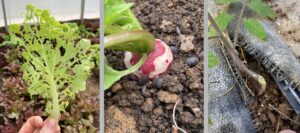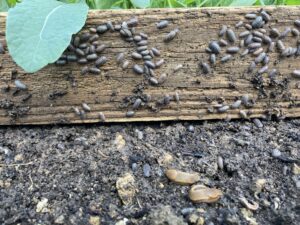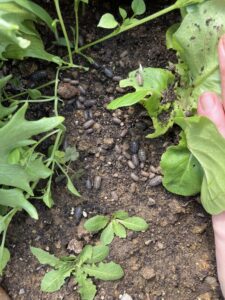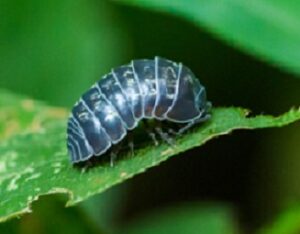Background
Pillbugs, roly-polys, and potato bugs are the dominant common names for the isopod genus Armadillidium spp. As the scientific name suggests, these little critters resemble mini armadillos but are, in fact, crustaceans that live on land (Figure 1). Therefore, they are more closely related to lobsters, crabs, and shrimp than insects. Pillbugs are important recyclers on farms, as they help to break down decaying organic matter to speed up the decomposition process. However, pillbugs can secondarily feed on fruits, vegetables, young shoots or roots, or lower leaves at the soil level, sometimes causing damage.
Examples of damage
Several growers this spring have reported pillbugs feeding on plant shoots and fruits (Figure 2). Feeding damage by pillbugs can resemble nibbling from mice, caterpillars (on leaves), or slugs. Most of this damage occurs at night and is concentrated at the soil level. They are also most common during springtime when the weather is cool and damp. It is currently unclear whether and to what extent pillbugs feed on roots below the soil surface. There are also suspicions that pillbugs climb plants at night, when they are most active, to feed on above-ground plant tissue.

Figure 2. Examples of pillbug feeding damage. Far left: Large irregular holes on lower lettuce leaf. Center: Radish tuber with damage and surrounded by pillbugs. Far right: suspected pillbug damage on tomato transplants (Photos by Samantha Willden).
Scouting
Because pillbug feeding damage can be misidentified, scouting plants at night or early in the morning is recommended to confirm pillbug presence. Area-wide scouting and monitoring of pillbugs can be done by placing wooden boards throughout a planting. Pillbugs will congregate under these covers during the day and can be counted to monitor pressure (Figure 3).

Figure 3. The underside of a 2 x 4” wooden board placed between rows of leafy greens. A congregation of pillbugs, and several slugs, can be seen in this image (Photo by Samantha Willden).
Management
There are currently no economic thresholds of injury levels for pillbugs. They are likely to be most problematic in damp, undisturbed soil with high organic matter levels. If they are identified as pests using the scouting methods above, preventative and cultural control practices are the best lines of defense. First, reduce the amount of organic material and hiding spots on the soil surface by removing dead or decaying plants, unnecessary plants or mulch, debris, and weeds within and around the planting. Increasing plant spacing will also help to reduce canopy cover and hiding spots for pillbugs during the day (Figure 4). Second, minimize soil surface wetness by irrigating crops only as needed. Lastly, placing wooden boards in the planting as described above will help to consolidate pillbugs that can be relocated by tapping the wooden boards to dislodge pillbugs in a new area. Consider moving pillbugs to compost piles away from vulnerable crops. Infested wooden boards can be soaked in soapy water to kill the pillbugs if a suitable relocation area is unavailable.

Figure 4. A cluster of pillbugs hiding below a dense plant canopy during the day (Photo by Samantha Willden).
Unfortunately, there is little information on spray recommendations for additional management of pillbugs. One resource from Texas A&M suggests pyrethroid insecticides, namely permethrin, for managing pillbugs. However, cultural control options of reducing suitable habitat and excess soil moisture are the most effective long-term solutions for pillbug management.
